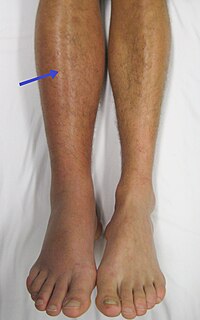
Photo from wikipedia
The application of catheter-based methods to treat acute deep vein thrombosis (DVT) has increased in recent years. Catheter-directed thrombolysis (CDT), introduced during the early 1990s, has shown the ability to… Click to show full abstract
The application of catheter-based methods to treat acute deep vein thrombosis (DVT) has increased in recent years. Catheter-directed thrombolysis (CDT), introduced during the early 1990s, has shown the ability to rapidly eliminate thrombus and is used in many centers as a salvage therapy for DVT patients who exhibit a poor initial response to anticoagulant therapy. However, CDT has disadvantages in terms of safety and resource use. Although CDT methods have evolved substantially to try to address these issues, for most of the last 25years there was little high-quality data on CDT outcomes upon which to base patient care decisions. The paucity of evidence was particularly problematic for long-term outcomes such as recurrent venous thromboembolism (VTE) and the post-thrombotic syndrome (PTS). Fortunately, rigorous studies of CDT are now being completed. Accordingly, the purpose of this article is to: 1) state the known and unknown factors influencing risk and benefit with use of CDT and related methods to treat acute DVT; 2) summarize emerging evidence showing the patient outcomes that occur when CDT is used for first-line management of DVT; and 3) suggest clinical parameters for CDT utilization in light of the available evidence.
Journal Title: Thrombosis research
Year Published: 2018
Link to full text (if available)
Share on Social Media: Sign Up to like & get
recommendations!